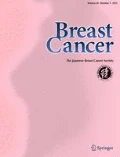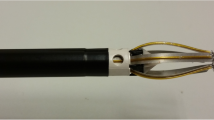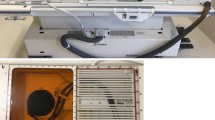Abstract
Background
Stereotactic vacuum assisted breast biopsy (VABB) procedures remain of key importance in the diagnostic evaluation of suspicious non-palpable mammographic lesions. The Breast Lesion Excision System® (BLES) is an image-guided percutaneous biopsy method that utilizes radiofrequency (RF) in order to retrieve an intact-tissue biopsy specimen. The purpose of this study is to determine the effects of RF application on the tissue specimen and the possible interference with the histopathologic results.
Methods
In this study we included 265 patients with suspicious non-palpable mammographic lesions who underwent 273 stereotactic VABB procedures using the BLES. All biopsies were performed by the same surgical-radiology team under local anesthesia. The specimen thermal damage was classified according to the pathology report in 3 categories: Severe (extensive thermal damage or inability to diagnose), medium (ability to diagnose but either circumferential damage >1.5 mm or diffuse areas of thermal damage) and mild (circumferential thermal damage <1.5 mm but >0.5 mm).
Results
Radiofrequency-associated thermal damage of the specimen was observed in 14 cases (5.13 %), and was classified as severe in 5, medium in 5, and mild in 4 specimens. Within the group of RF damaged specimens, we found a significant (p < 0.05) positive correlation between fat cell content and classification of thermal damage.
Conclusions
Although thermal damage is of concern during BLES breast biopsy, the incidence is low, and the outcome of the histopathologic assessment is not affected even in severely damaged specimens. Increased thermal damage seems to correlate with higher fat cell content of the specimen.




Similar content being viewed by others
References
Liberman L. Centennial dissertation. Percutaneous imaging-guided core breast biopsy: state of the art at the millennium. AJR Am J Roentgenol. 2000;174:1191–9.
Guray M, Sahin AA. Benign breast diseases: classification, diagnosis, and management. Oncologist. 2006;11:435–49.
Zografos GC, Zagouri F, Sergentanis TN, Nonni A, Koulocheri D, Fotou M, et al. Minimizing underestimation rate of microcalcifications excised via vacuum-assisted breast biopsy: a blind study. Breast Cancer Res Treat. 2008;109:397–402.
Al-Harethee W, Papanagiotou I, Grigoropoulos P, Filippakis GM, Zografos GC. Breast lesion excision system—intact® (B.L.E.S.): a novel stereotactic method of biopsy utilizing radiofrequency for suspicious non-palpable mammographic lesions. Cancer Res. 2010;70:P6-02–4.
Killebrew LK, Oneson RH. Comparison of the diagnostic accuracy of a vacuum-assisted percutaneous intact specimen sampling device to a vacuum-assisted core needle sampling device for breast biopsy: initial experience. Breast J. 2006;12:302–8.
Seror JY, Lesieur B, Scheuer-Niro B, Zerat L, Rouzier R, Uzan S. Predictive factors for complete excision and underestimation of one-pass en bloc excision of non-palpable breast lesions with the Intact (R) breast lesion excision system. Eur J Radiol. 2012;81:719–24.
Sie A, Bryan DC, Gaines V, Killebrew LK, Kim CH, Morrison CC, et al. Multicenter evaluation of the breast lesion excision system, a percutaneous, vacuum-assisted, intact-specimen breast biopsy device. Cancer. 2006;107:945–9.
Reston VA. BIRADS atlas. 4th ed. USA: American College of Radiology; 2003.
O’Flynn EA, Wilson AR, Michell MJ. Image-guided breast biopsy: state-of-the-art. Clin Radiol. 2010;65:259–70.
Luparia A, Durando M, Campanino P, Regini E, Lucarelli D, Talenti A, et al. Efficacy and cost-effectiveness of stereotactic vacuum-assisted core biopsy of nonpalpable breast lesions: analysis of 602 biopsies performed over 5 years. Radiol Med. 2011;116:477–88.
Whitworth PW, Simpson JF, Poller WR, Schonholz SM, Turner JF, Phillips RF, et al. Definitive diagnosis of high-risk breast lesions without open surgical excision: the intact percutaneous excision trial (IPET). Ann Surg Oncol. 2011;18:3047–52.
Liberman L, Sama MP. Cost-effectiveness of stereotactic 11-gauge directional vacuum-assisted breast biopsy. AJR Am J Roentgenol. 2000;175:53–8.
Allen SD, Nerurkar A, Della Rovere GU. The breast lesion excision system (BLES): a novel technique in the diagnostic and therapeutic management of small indeterminate breast lesions? Eur Radiol. 2011;21:914–25.
Al-Harethee W, Theodoropoulos G, Filippakis GM, Papapanagiotou I, Matiatou M, Georgiou G, et al. Complications of percutaneous stereotactic vacuum assisted breast biopsy system utilizing radio frequency. Eur J Radiol. 2012;. doi:10.1016/j.ejrad.2011.12.023. (online 9 January 2012).
Athanassiou E, Sioutopoulou D, Vamvakopoulos N, Karasavvidou F, Tzovaras G, Tziastoudi E, et al. The fat content of small primary breast cancer interferes with radiofrequency-induced thermal ablation. Eur Surg Res. 2009;42:54–8.
Acknowledgments
The authors would like to thank Mr. Ilias Mamouras, M.Sc., for revising the statistical data analyses presented in the manuscript.
Conflict of interest
The authors declare no conflict of interest.
Author information
Authors and Affiliations
Corresponding author
About this article
Cite this article
Al-Harethee, W.A., Kalles, V., Papapanagiotou, I. et al. Thermal damage of the specimen during breast biopsy with the use of the Breast Lesion Excision System: does it affect diagnosis?. Breast Cancer 22, 84–89 (2015). https://doi.org/10.1007/s12282-013-0458-2
Received:
Accepted:
Published:
Issue Date:
DOI: https://doi.org/10.1007/s12282-013-0458-2




